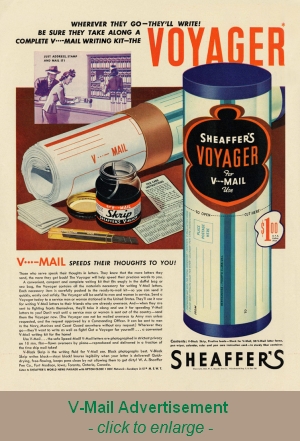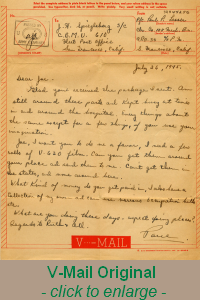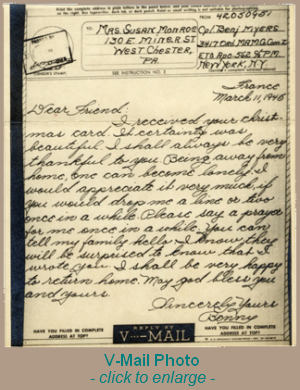Army Signal Corps World War II V-Mail Service
 Different
from the VMail we know of today, the V-Mail of World
War II was a curious thing. Copied from the British Airgraph
Service of the time, but renamed as "victory mail" or
"V-Mail" for American use, on June 15, 1942,
this form of communication between family members
back in America and their sons on the front-line
throughout the world, began to take place. Working
in both directions, from America to the front lines,
and from the front lines back to America, It
continued to be used until April
1, 1945. The reason it was created was three fold: i)
to reduce the size and cost of mail that was being
shipped from America to G.I.'s around the world, ii)
to get the mail through faster, and iii) to make it
easier for censors to review the tons of mail that
was being sent. Uniquely, it was the Signal Corps'
responsibility to run this service.
Different
from the VMail we know of today, the V-Mail of World
War II was a curious thing. Copied from the British Airgraph
Service of the time, but renamed as "victory mail" or
"V-Mail" for American use, on June 15, 1942,
this form of communication between family members
back in America and their sons on the front-line
throughout the world, began to take place. Working
in both directions, from America to the front lines,
and from the front lines back to America, It
continued to be used until April
1, 1945. The reason it was created was three fold: i)
to reduce the size and cost of mail that was being
shipped from America to G.I.'s around the world, ii)
to get the mail through faster, and iii) to make it
easier for censors to review the tons of mail that
was being sent. Uniquely, it was the Signal Corps'
responsibility to run this service.
Once V-Mail was implemented, it quickly became obvious that where it had taken up to a month for
standard mail delivery by be shipped and arrive, V-Mail delivery
could be accomplished in as little as twelve days or less, using
aircraft. Air transport also had the added benefit
of minimizing the likelihood of enmy interception,
although censors still insured that any potentially
useful or damaging information was deleted from all
messages. One final benefit was that letters could
never be "lost in the mail." This became
so, because serial numbers were added to V-Mail forms, while the original was held on file.
In this way, any message
that was lost in transit could be reproduced and
sent to the addressee at a later date.
The way it worked was simple: a person who wanted to send a letter by airgraph or
V-Mail would obtain a standard, pre-printed form
from their local post office or five and dime store.
The cost of the form was usually a dollar, and included all shipping/mailing
costs. Front line soldiers usually got their forms from Supply. In both cases, the form contained space for a letter of
about 100 to 300 words. In both cases a space was
reserved for the address of the
serviceman or servicewoman to whom the letter was to
be delivered (or the person back home receiving it), the address of the sender, and a
circular area for the censor's stamp of approval. Once the message was written, the form was folded
and sealed. It then made its way to a processing
center where the form was re-opened and fed through
a machine that photographed the letters on 16mm
film. A
continuous roll of this film (100 feet long
by 16mm wide) could hold up to 1,700 messages and,
with the metal container it was housed in, weighed
5.5 oz. A sack of mail holding the same number of
regular letters would have weighed 50 lbs.
When the
V-Mail reached the destination, it was sent to a
local processing facility that reversed the process,
printing photographs of the letters to be sent to
the intended recipient in a three inch by four inch
envelope.


 Different
from the VMail we know of today, the V-Mail of World
War II was a curious thing. Copied from the British Airgraph
Service of the time, but renamed as "victory mail" or
"V-Mail" for American use, on June 15, 1942,
this form of communication between family members
back in America and their sons on the front-line
throughout the world, began to take place. Working
in both directions, from America to the front lines,
and from the front lines back to America, It
continued to be used until April
1, 1945. The reason it was created was three fold: i)
to reduce the size and cost of mail that was being
shipped from America to G.I.'s around the world, ii)
to get the mail through faster, and iii) to make it
easier for censors to review the tons of mail that
was being sent. Uniquely, it was the Signal Corps'
responsibility to run this service.
Different
from the VMail we know of today, the V-Mail of World
War II was a curious thing. Copied from the British Airgraph
Service of the time, but renamed as "victory mail" or
"V-Mail" for American use, on June 15, 1942,
this form of communication between family members
back in America and their sons on the front-line
throughout the world, began to take place. Working
in both directions, from America to the front lines,
and from the front lines back to America, It
continued to be used until April
1, 1945. The reason it was created was three fold: i)
to reduce the size and cost of mail that was being
shipped from America to G.I.'s around the world, ii)
to get the mail through faster, and iii) to make it
easier for censors to review the tons of mail that
was being sent. Uniquely, it was the Signal Corps'
responsibility to run this service.
